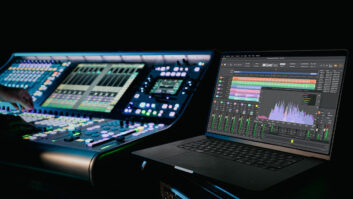The Great Indoors
Sep 1, 1999 12:00 PM,
Ted Uzzle
The primary responsibility of architectural acoustics is to exclude outsidesounds that would disturb hearing conditions. This can be especiallydifficult when the noises produced by a particular venue are not higher inlevel than the potentially intrusive sounds coming from outside thebuilding. In outdoor facilities or facilities that produce a high level ofsound – as with open air-arenas and sports facilities – there is usually notrouble overcoming the noise that might otherwise infiltrate. Often, themore important noise-control task is preventing stadium noise from annoyingneighbors.
Construction practices need to be tightened up considerably in venues thatare more susceptible to outside noise. Attention must be focused oninsulation choices, doorways, window treatments, HVAC and structurallyborne sounds if the facility is attached in anyway to other buildings orunits. Designing and building schemes for reducing noise and sound proofingis an involved topic, and this article will focus on understanding themechanisms involved in sound’s behavior in rooms.
Temporal sound behavior
Sound in a room changes over time. (See Figure 1.) A sound source in a roomis turned on at time t subscript 1, allowed to operate for an interval andturned off at time t subscript 3. Its duration is thus t subscript 3 – tsubscript 1.
>From a listening position elsewhere in the room, we observe the sound>pressure produced as a result. At point B in Figure 1, the pressure wave>passes the listening position. It has arrived at time t subscript 2. We>now know the distance between the sound source and the listening position>is:
c / (t subscript 2 – t subscript 1)
where c is the speed of sound.
The sound pressure continues at the same level as the sound sourcecontinues to produce sound power. Soon the first, early reflections arriveat the listening position. These either add to or subtract from thepressure already observed, according to the phase relationships between thedirectly arriving sound and the reflected sound. They will usually add tosome degree rather than subtract if the sound source is producing a rapidlyfluctuating signal, such as random noise or speech. At points C and D inthe graph, we see discrete increases in pressure as reflected sounds add tothe direct sound.
At some time, t subscript 4 in this graph, a bundle of sound energyreflected from various room surfaces begins to arrive. From point E topoint F in the graph, the pressure rises, not in discrete steps but in asomewhat shaky diagonal rise.
>From points F to G in the graph, the source and its room-wide reflections>are in a sort of equilibrium. The amount of sound power entering the room>from the source and the amount of sound power leaving the room are in>balance. Sound power might leave through an open window or door. It might>leave by being transmitted outside through a vibrating boundary panel>(re-radiated on the other side) or through the structure of the building.>It might also leave through dissipation, by being converted to heat at the>boundary of the room. We call these phenomena absorption; we will discuss>that a bit later.
What if the sound source contributed power forever? What if no power leftthe room? What if the room were perfectly enclosed, perfectly rigid andperfectly reflective? The room would explode when the enclosed sound powerbecame great enough to break the boundaries and the structure that supportsthem.
The sound-pressure level between points F and G is greater than thesound-pressure level at point B. The difference in level is what used to becalled room gain. That term has rightly fallen into disfavor because theroom is a passive device and incapable of contributing gain to the soundpower inside it. Although for some years the industry jargon adopted thesemantic blooper, it is an important point: In sufficiently reflectiverooms, the total sound pressure at many listening positions is greater thanthe direct sound alone.
At time t subscript 5, the equilibrium is broken because the sound sourcehas been shut off. From point G to point H, the sound pressure drops. Itdrops at a rate (in dB per second) determined by the rate at which soundpower is lost from or dissipated in the room. This is a characteristic ofthe room, having almost nothing to do with the sound source.
If the sound pressure drops 60 dB, the time interval t subscript 6 – tsubscript 5 is the reverberation time. This is one of the most criticallyimportant acoustical characteristics of the room, and its relationship tothe physical room is:
T=0.049 V/A
where T is the reverberation time; V is the room cubic volume in ftsuperscript 3, and A is the total absorption in the room, figured withcustomary units (feet). The 0.049 is a unit-correction constant.
In systeme international units:
T=0.161 V/A
where V is the room cubic volume in m superscript 3, and A is the totalabsorption in the room figured with metric units.
The application of this equation can reveal some interesting things.Namely, double the sound absorption in the room while holding the room’svolume the same, and the reverberation time drops by half. Also, double theenclosed room’s volume, holding absorption unchanged, and you double thereverberation time. The reason for this is that in a bigger room, soundtakes longer to be reflected from one absorbing surface to another. Thatseems simply a function of the longer sound-transit times betweeninteractions with boundaries.
It is not quite that simple. Double the volume of a cube, and the distancefrom side to side (and thus the sound transit time) lengthens only 26%.Remember that we have doubled the volume while keeping the absorption thesame. If the same total absorption were spread evenly over all thesurfaces, it would only absorb 74% as much per unit area. Not only are thepath lengths longer, but more reflections are also required for 60 dBattenuation of the reflected sound.
How sound is converted to heat
Where did that term A in the reverberation equation come from? Whatprecisely does acoustic absorption mean? Read what Charles Dickens wrote in1842:
Among the narrow thoroughfares at hand, there lingered, here and there, anancient doorway of carved oak, from which, of old, the sounds of revelryand feasting often came; but now these mansions, only used for storehouses,were dark and dull and, being filled with wool and cotton and the like -such heavy merchandise as stifles sound and stops the throat of echo – hadan air of palpable deadness about them which, added to their silence anddesertion, made them very grim. (Dickens, 1844)
Dickens put it well: Wool, cotton and the like stifling sound and stoppingthe throat of echo. There it is, 150 years ago: Fuzzy stuff absorbs sound.It does so by being moved infinitesimally as the air molecules around itmove.
Imagine waves rolling onto the seashore. They roll over damp, compactedsand without effect on it and continue rolling until their kinetic energyis exhausted. Now, imagine a hurricane has raised the seas, and the wavesare rolling across a grassy lawn. Every time the waves ebb and flow, theblades of grass flop back and forth. The waves are now expending theirkinetic energy by moving blades of grass, and under these circumstances,the same kinetic energy will not roll so far inland. (See Figure 2.)
If a door or window is at the room boundary with nothing beyond it toreflect sound back into the room, all sound falling on the open area willleave the room forever. This counts as acoustic absorption. Itsabsorptivity is an index of the rate at which it absorbs sound. An openwindow has an absorptivity of 1; all sound falling on it is absorbed. Itsabsorption is 1 times the open area.
If the area is calculated in square feet, this product is denominated incustomary sabins. If the area is figured in square meters, this product isdenoted in metric sabins. The sabin is the international unit of acousticabsorption, named after Sabine. Ordinary acoustic work will usually beconducted in all feet or all meters; whether the sabin is customary ormetric is inferred from the context.
Fiberglass fuzz is highly absorptive, although it does not absorb quite allthe sound. Its absorptivity is 0.8; that means 80% of the sound falling onit is absorbed. The absorption of its surface is 0.8 times the area exposedto the sound.
Brick, on the other hand, absorbs little and reflects most of the soundfalling on it. Its absorptivity is 0.02, absorbing just 2% of the soundthat strikes it. Thus, 98% of the sound that strikes brick is reflectedback.
So far, we have covered only wall surfaces and finishes. Fully roundobjects in the room also absorb sound. A person standing away from nearsurfaces absorbs about 4.5 customary sabins (about 0.4 metric sabins). Ifthe person were leaning against a wall, not so much absorbing surface wouldbe exposed to the sound, so the absorption would be less. If the personwere seated, the same would apply. When audience members in large spacesare seated, they are not counted as individual absorbers but rather as asurface area of a certain absorptivity. The absorptivity of an audiencedepends on the type of chairs they occupy and the percentage of chairsoccupied when not all the chairs are full.
Absorptivity depends greatly on frequency because different materialsabsorb different amounts at different wavelengths. This is whyabsorptivities are ordinarily calculated quoted at a variety of frequencies.
Absorptivity of commercially available wall finishes also depends on theway the finish is mounted. Most absorbers work more efficiently at lowerfrequencies if an air space is behind them.
Sound distribution in architectural space
It will not surprise anyone who has attended an event in such a large spaceas an arena with a sound system that sound is not distributed evenlythroughout the room. We have already considered sound distribution in time;it is now necessary to study the sound distribution in space.
We saw from the phenomenon of spreading losses that as we get farther awayfrom the sound source, the sound coming directly from the source is at acorrespondingly decreasing level. Something additional happens in areverberant space: A reverberant field is created. This is sound of equallevel throughout the space arriving from completely random directions andwith a completely random phase relationship to the sound arriving directlyfrom the sound source. In Figure 1, the reverberant field predominated frompoints F to G and from point G to point H; the decrease in sound level wasthe reverberant field dying away.
Imagine molasses being poured into a kitchen strainer. The fluid enters thestrainer at one point but drips out over the entire bottom of the strainer.A dimple is at the point where the stream of molasses is introduced, butthe surface is flatter from there to the edge of the strainer. This issomething like the way sound distributes itself in a room: It enters at onepoint, the sound source, but it leaves by being absorbed through all theinterior surfaces. The level is greatest near the source but much moreuniform far away.
Figure 3 shows sound distributed in a reverberant room; the diagonal lineshows spreading loss. If we are far enough away from the source for it toapproximate a point source, this line will slant downward at 20 log x, arate of -6 dB per doubling of distance. The horizontal line is the level ofthe reverberant field, constant at all distances in the room.
To calculate the level of this reverberant sound, in decibels relating to20 mPa, you need to know L subscript w, the power level of the sound sourcein decibels relative to one picowatt (10 superscript -12 W). You also needto know the room volume in cubic feet (ft superscript 3) and thereverberation time. Use this formula:
L subscript w + 10 log (T/V) + 29.6
If the room volume is in m superscript 3, use this formula:
L subscript w + 10 log (T/V) + 19.3
Notice distance x from the source does not enter into these S equationsbecause this level exists at all distances in the room.
To calculate the total sound-pressure level, direct sound plus reverberantsound, at any distance x we also need to know the directivity factor, Q, ofthe sound source. This is the formula using customary units:
L subscript w + 10 log (Q/4px superscript 2 + 81.6T/V) + 10.5
This is the formula using metric units:
L subscript w + 10 log (Q/4px superscript 2 + 24.8T/V) + 0.2
Where direct sound predominates, we get direct sound level; wherereverberant sound predominates, we get reverberant sound level. Wheredirect and reverberant sound levels are equal, it will give the sum of thetwo, 3 dB higher than either.
When the power of the sound source is increased or decreased, both directand reverberant levels increase by the same number of decibels. (See Figure4.) The distances at which each predominate remains the same.
When the absorption in the room, and thus the reverberation time, changes,the reverberant level changes with it, whether increasing or decreasing.(See Figure 5.) The change in reverberant pressure level changes thus:
-10 log (A subscript 1 / A subscript 2)
This means that if the absorption doubles, -10 log 2 = -3 dB change, and ifthe absorption is reduced to 25%, -10 log 0.25 = +6 dB change.
When the directivity of the sound source changes, the distance at whichdirect sound and reverberant sound are equal changes. (See Figure 6.) Thisdistance changes with the square root of the sound source’s directivityfactor, Q. When the Q doubles, the distance at which direct sound andreverberant sound are equal moves away by 41%. For this distance to double,the Q must increase by a factor of 4.
The distribution of amplified sound in any venue obviously has much to dowith the characteristics of the loudspeakers chosen, where the loudspeakersare placed and the direction in which they are aimed. In November, S&VCwill cover the issues of sound out of doors and offer a number of soundreinforcement installation profiles that will illustrate the use ofloudspeakers in real-life applications.










